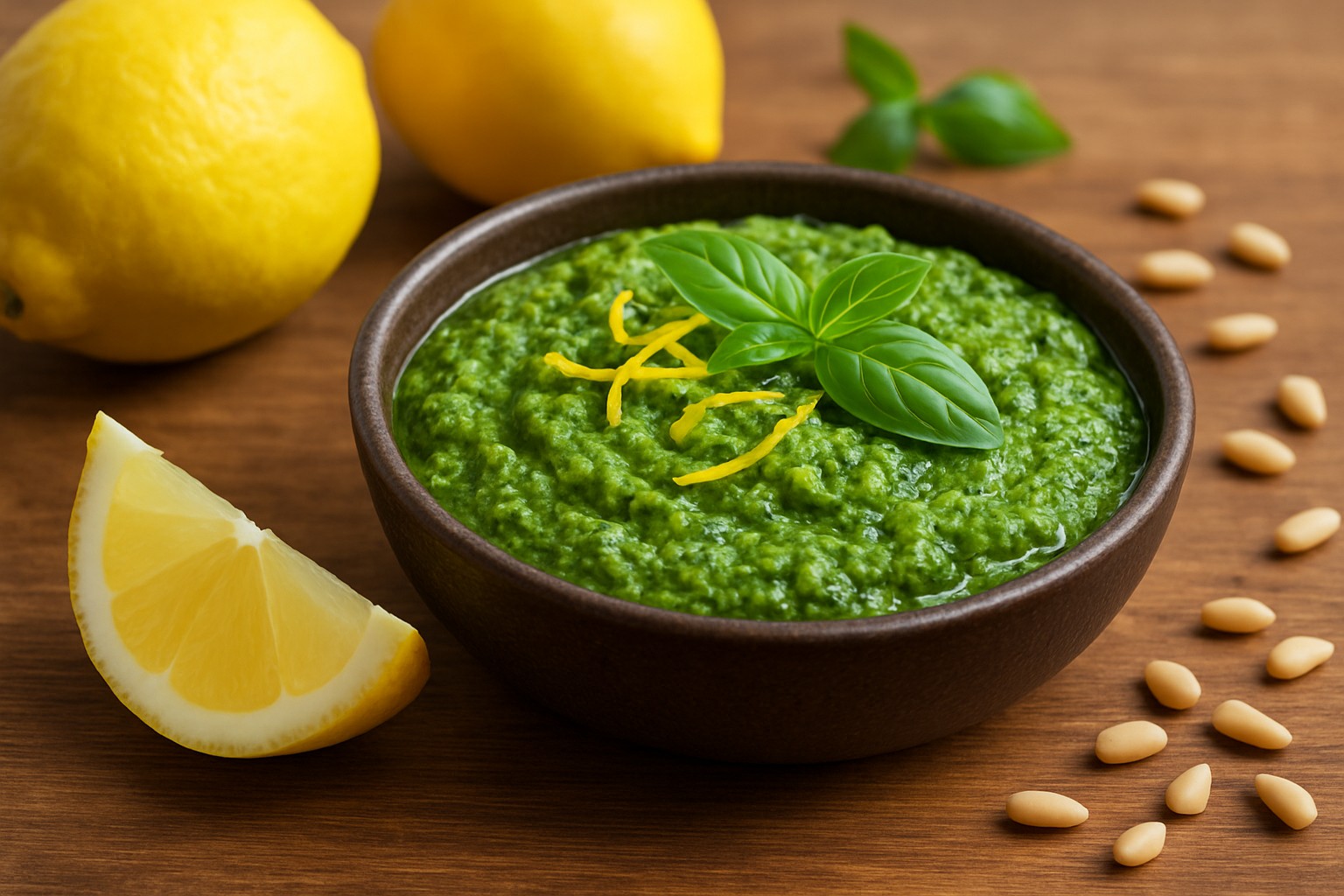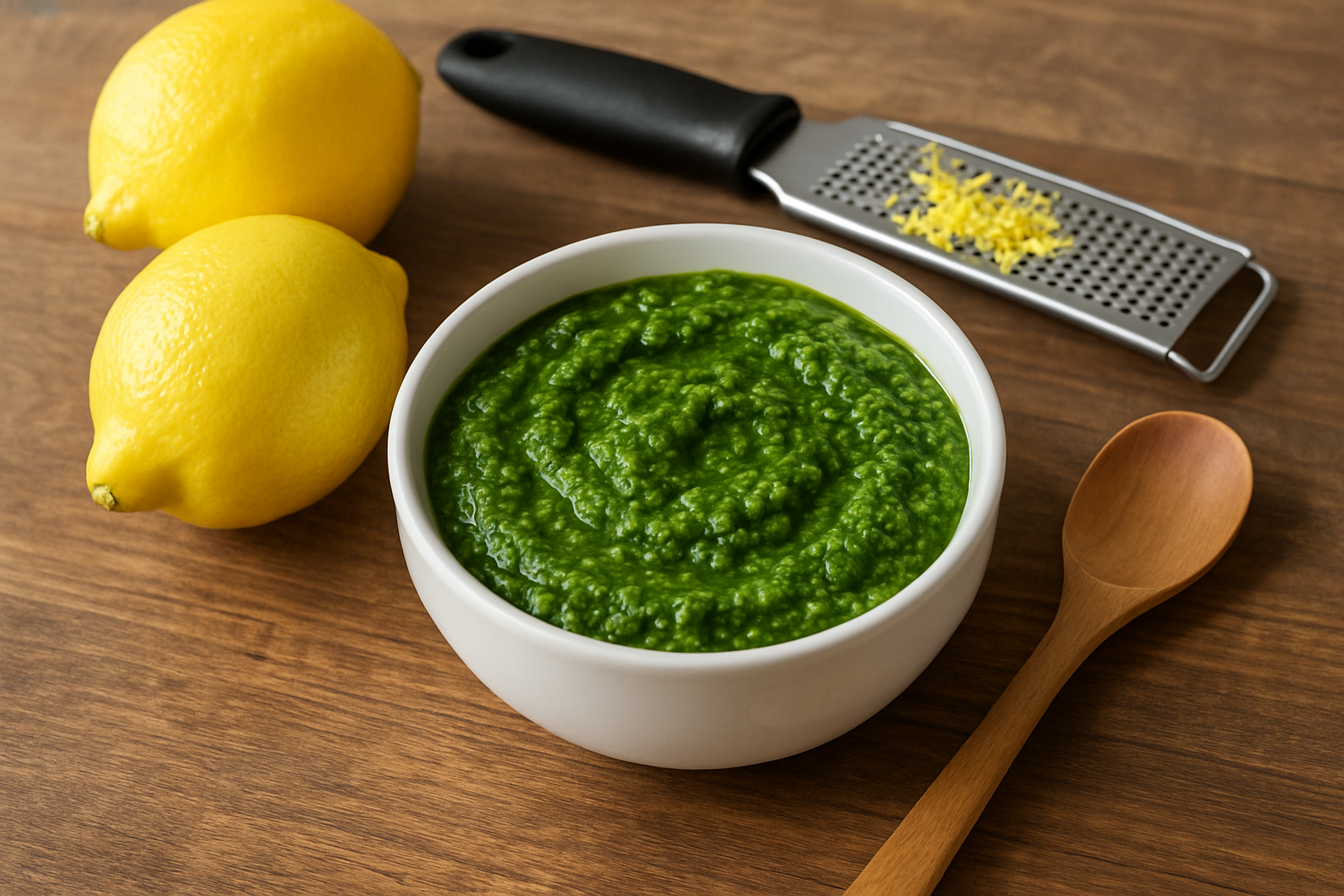How To Use Lemon in Pesto for Fresh Flavor

Adding lemon to pesto is a clever trick to brighten this beloved Italian sauce with fresh zesty flavor. Lemon brings a lively acidity that cuts through the richness of cheese and olive oil. Its zest adds a fragrant lift that wakes up your taste buds. You’ll discover why lemon pairs so well with pesto. Get the lowdown on the best citrus varieties to use and follow a straightforward step-by-step guide to make the most of lemon’s magic.
Getting to Know Traditional Pesto and What It Really Tastes Like
Classic pesto is a vibrant Italian sauce bursting with fresh basil, pine nuts, Parmigiano-Reggiano cheese, garlic and a generous drizzle of olive oil. Its flavor hits you with a delightful mix of herbaceous and nutty notes. It is salty and rich, carrying that unmistakable fresh-from-the-garden charm.
Why Toss a Squeeze of Lemon into Your Pesto? The Benefits and How It Brings Out Flavor
Lemon brings a zesty punch of lively acidity and a fresh citrus scent that dances beautifully with the herbal notes of basil and the earthy depth of nuts. Its bright sunny character helps cut through the richness of the cheese and olive oil and creates a more balanced and vibrant flavor that really wakes up the palate.
- Lemon injects a fresh brightness that lifts the pesto’s flavor to another level.
- Its zesty citrus acidity cuts through and balances the rich creaminess of the cheese and olive oil.
- Lemon zest releases fragrant oils that perk up the aroma and taste, giving your pesto extra personality.
- The natural preservatives in lemon juice help keep the pesto fresh a bit longer—always a welcome bonus in my experience.
- Tossing in lemon adds a unique twist to the classic recipe, making it lively and bright without trying too hard.
Different Kinds of Lemons and Citrus to Choose for Pesto (Because Not All Lemons Are Created Equal)
Picking the right lemon or citrus type can subtly nudge the flavor of your pesto in exciting directions. The classic Eureka lemon delivers bright acidity and a zesty sharp citrus punch that works well in any pesto recipe. Meyer lemons tend to be sweeter and less zingy with delicate floral hints that lend a softer almost cuddly citrus note that pairs beautifully with basil. If you venture beyond lemons, limes bring a tangy slightly bitter flair. Citron offers a more intense almost perfumed citrus aroma that really wakes things up.
| Citrus Type | Flavor Notes | Acidity Level | Best Use Case |
|---|---|---|---|
| Eureka Lemon | Bright and sharp, packing that classic lemon punch | High | Perfect for lending a zesty kick to traditional pesto |
| Meyer Lemon | Sweet and floral, with a gentler, mellow acidity | Medium-Low | Great when you want a softer, sweeter pesto blend |
| Lime | Tangy with a hint of bitters that keeps things interesting | High | Adds a bold, tangy twist that wakes up any pesto |
| Citron | Strong citrus flavor wrapped in fragrant, floral notes | Medium | Just right for whipping up an exotic pesto with a lovely floral aroma |
Step-by-Step Guide on Adding Lemon to Your Pesto (Because a Little Zest Goes a Long Way)
Before you toss in your lemon double-check that all your ingredients are fresh and ready to go. Pick out basil leaves that are nice and green, avoiding any with a hint of brown—that's a dead giveaway they’re past their prime. Grate your cheese freshly for that perfect melt-in-your-mouth texture, and don’t skimp on using a good-quality extra virgin olive oil—it really makes all the difference. When it comes to zesting lemons, keep clear of that bitter white pith lurking underneath the skin. I’ve found a fine grater or microplane works like a charm for getting just the right amount of zest.
- Start with firm unwaxed lemons if you want the freshest zest and juiciest juice—there’s simply no substitute.
- Make sure to wash and dry those lemons thoroughly before zesting since nobody wants little bits of dirt sneaking in.
- When zesting, use a microplane grater to shave off only the bright yellow peel and avoid the bitter white pith underneath.
- Slice the lemons in half and juice them, taking care to strain out any pesky seeds and pulp.
- Toss the lemon zest into your basil, nuts and garlic mix before blending because it really helps wake up those essential oils.
- After blending slowly stir in the lemon juice so you can keep the acidity in check and balance the flavors just right.
- Give it a taste and adjust the seasoning as you like. Then store the pesto in an airtight container topped with a slick of olive oil to keep it fresh.

A bowl of vibrant basil pesto with fresh lemons and zesting tools nearby, ready to add fresh lemon flavor.
Helpful Tips for Making Lemon-Infused Pesto That Really Works (No Fuss, Just Flavor)
- Go for organic lemons if you can. It is better to avoid any lingering pesticide traces since the zest comes straight from the peel.
- Toss the lemon zest in before blending so those fragrant oils mingle nicely throughout the whole mix.
- Add the lemon juice after blending to tweak the acidity and freshness just right instead of guessing upfront.
- If the pesto tastes a bit too sharp, try mellowing it out with a pinch of sugar or an extra dash of salt to find the perfect balance.
- Be careful with the lemon juice because too much can bring bitterness and take away from the classic pesto flavor.
Lemon juice is naturally acidic which does a pretty good job of slowing oxidation and stopping pesto from turning that unappetizing brown too quickly. To keep your lemon pesto fresh a little longer, pop it in an airtight container in the fridge and do not forget to slick a thin layer of olive oil over the surface—it’s like a little protective cloak. Using freshly squeezed lemon juice when whipping it up also gives it a nice boost in preservation.
Inspired Ways to Use Lemon in Pesto (Because Everything’s Better with a Zesty Twist)
Lemon pesto is surprisingly versatile and pairs effortlessly with pasta, grilled veggies and seafood to bring out the best in each. It’s also a fantastic zesty spread for sandwiches or a delightful mix-in for creamy cheeses like ricotta. It’s perfect for appetizers that get people’s taste buds tingling.
- Toss cooked pasta and halved cherry tomatoes with lemon pesto for a wonderfully simple, fresh dish that never fails to brighten the table.
- Marinate chicken breasts in lemon pesto before grilling to infuse them with a lively, zesty punch that really wakes up your taste buds.
- Drizzle lemon pesto over roasted potatoes or veggies to give them an unexpectedly bright, flavorful twist that can turn even the most basic side into something special.
- Mix lemon pesto with creamy ricotta and spread it on toasted crostini for a refined appetizer that’s sure to impress, yet easy enough to whip up in a flash.
Questions & Answers
Additional Resources
- Bon Appétit Magazine - The go-to trusted voice when you want to chat all things food and cooking
- Serious Eats - Diving headfirst into culinary science and clever cooking techniques
- America's Test Kitchen - Where trusted recipes are put through their paces with a no-nonsense approach
- The Kitchn - Your friendly neighborhood source for practical kitchen tips and home cooking know-how




